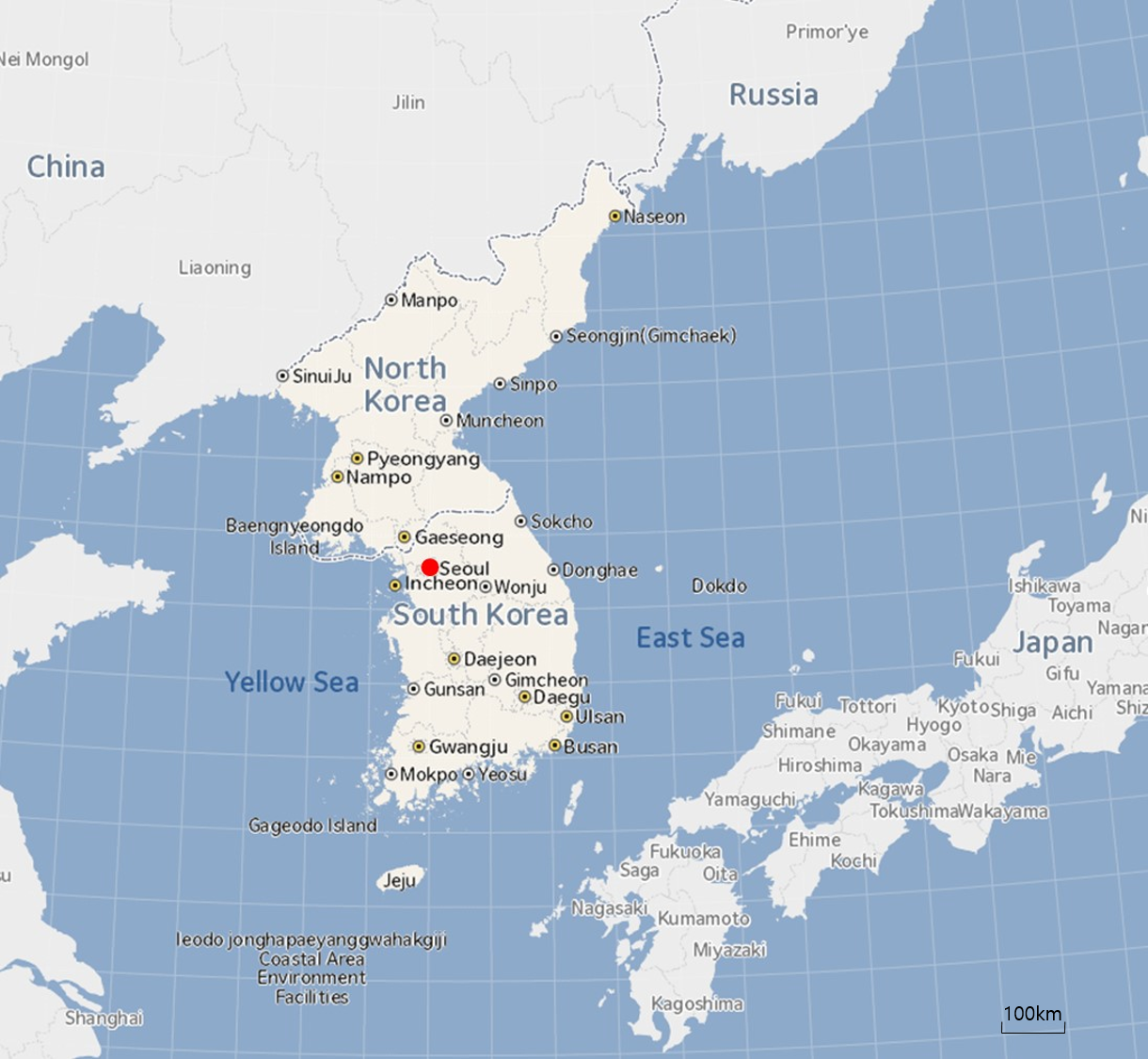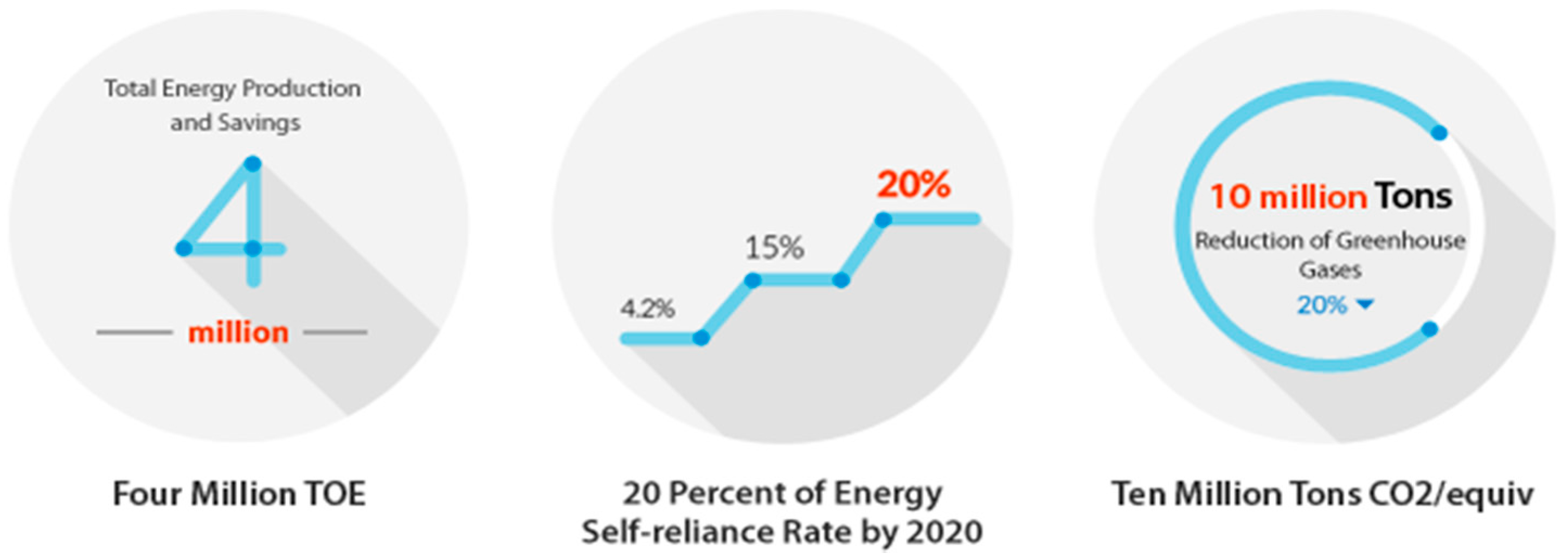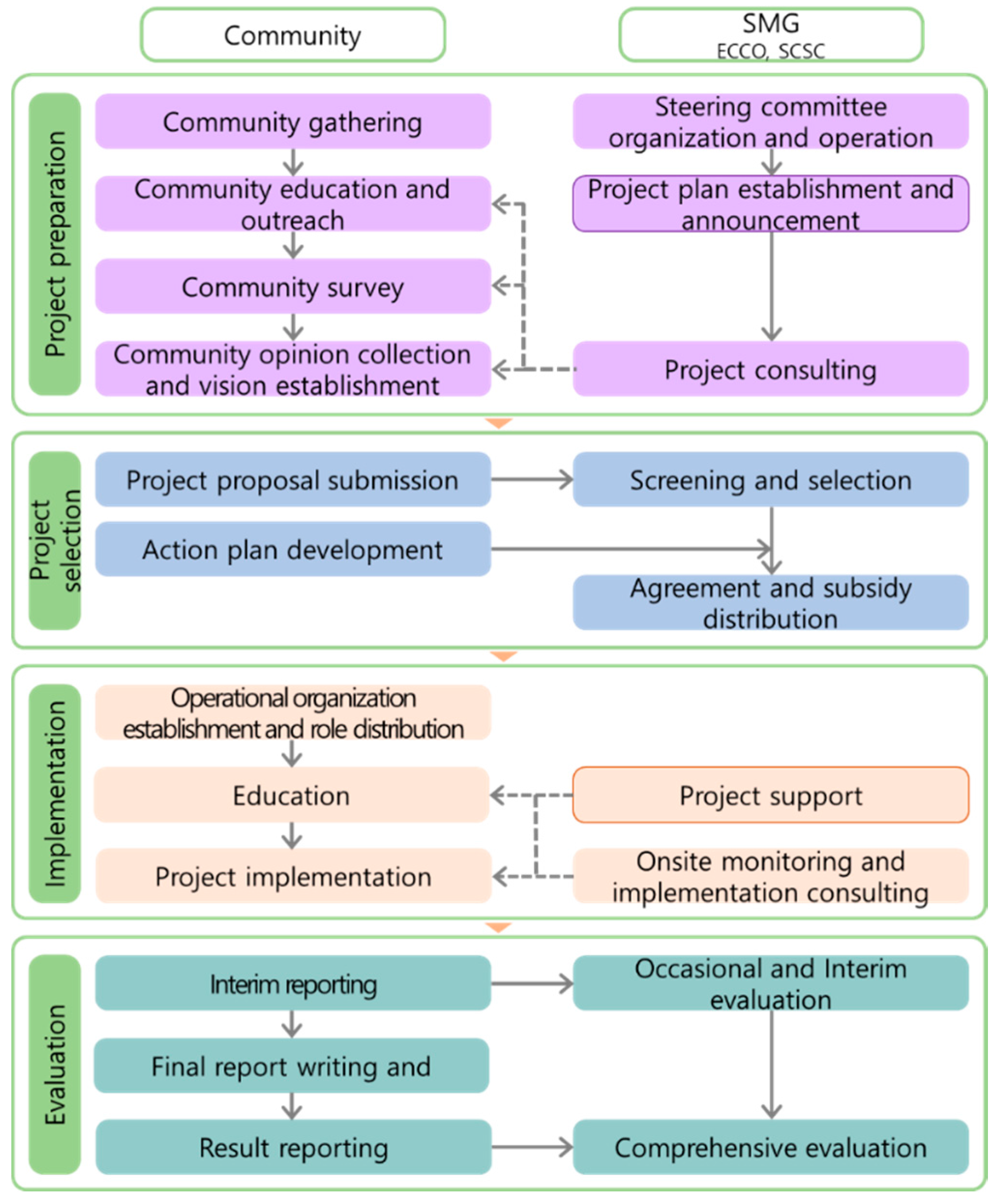A Community Energy Transition Model for Urban Areas: The Energy Self-Reliant Village Program in Seoul, South Korea
Abstract
:1. Introduction
2. Communities for Energy Transition
2.1. Communities for Energy Transition
2.2. Internal and External Context Related to Communities for Energy Transition
3. Methodology
4. Two Visions for One: One Less Nuclear Power Plant Policy and Community Building Project
4.1. One Less Nuclear Power Plant Policy (OLNPP)
4.2. Community Building Project (CBP)
5. Community Energy Initiatives in Seoul: The Energy Self-Reliant Village Program
5.1. The Status of Energy Self-Reliant Villages
5.2. The Achievements of Energy Self-Reliant Villages
5.2.1. The Quantitative Achievements of Energy Self-Reliant Villages
5.2.2. The Qualitative Achievements of Energy Self-Reliant Villages
6. Municipal Support for the Energy Self-Reliant Villages
6.1. Municipal Support for Energy Self-Reliant Villages Regarding External Conditions
6.1.1. Municipal Support for Energy Self-Reliant Villages Regarding Technological Conditions
6.1.2. Municipal Support for Energy Self-Reliant Villages Regarding Non-technological Conditions
6.2. Municipal Support for Energy Self-Reliant Villages Regarding Internal Context
6.3. The Role of the Municipal Government in Creating Enabling Conditions
7. Unsolved Internal and External Challenges to Energy Self-Reliant Villages
7.1. External Challenges to the Energy Self-Reliant Villages
7.2. Internal Challenges to the Energy Self-Reliant Villages
8. Conclusions
Acknowledgments
Conflicts of Interest
References
- Petersen, J.-P. Energy concepts for self-supplying communities based on local and renewable energy sources: A case study from northern Germany. Sustain. Cities Soc. 2016, 26, 1–8. [Google Scholar] [CrossRef] [Green Version]
- Feldhoff, T. Asset-based community development in the energy sector: Energy and regional policy lessons from community power in Japan. Int. Plan. Stud. 2016, 21, 261–277. [Google Scholar] [CrossRef]
- Magnani, N.; Osti, G. Does civil society matter? Challenges and strategies of grassroots initiatives in Italy's energy transition. Energy Res. Soc. Sci. 2016, 13, 148–157. [Google Scholar] [CrossRef]
- Burchell, K.; Rettie, R.; Roberts, T.C. Householder engagement with energy consumption feedback: The role of community action and communications. Energy Policy 2016, 88, 178–186. [Google Scholar] [CrossRef]
- Rogers, J.C.; Simmons, E.A.; Convery, I.; Weatherall, A. Social impacts of community renewable energy projects: Findings from a woodfuel case study. Energy Policy 2012, 42, 239–247. [Google Scholar] [CrossRef]
- Hargreaves, T.; Hielscher, S.; Seyfang, G.; Smith, A. Grassroots innovations in community energy: The role of intermediaries in niche development. Glob. Environ. Chang. 2013, 23, 868–880. [Google Scholar] [CrossRef] [Green Version]
- Bauwens, T. Explaining the diversity of motivations behind community renewable energy. Energy Policy 2016, 93, 278–290. [Google Scholar] [CrossRef]
- REScoop. Facts & Figures. Available online: https://rescoop.eu/facts-figures-0 (accessed on 8 July 2017).
- REN21. Renewable 2016 Global Status Report; Renewable Energy Policy Network for the 21st Century: Paris, France, 2016. [Google Scholar]
- Klein, S.J.W.; Coffey, S. Building a sustainable energy future, one community at a time. Renew. Sustain. Energy Rev. 2016, 60, 867–880. [Google Scholar] [CrossRef]
- Ranade, S.N. Urban community development—Its nature and scope. Econ. Wkly 1959, 11, 1501–1502. [Google Scholar]
- Secretary General of the United Nations. The applicability of community development to urban areas. Ek 1961, 12, 284–288. [Google Scholar]
- McMillan, D.W.; Chavis, D.M. Sense of community: A definition and theory. J. Community Psychol. 1986, 14, 6–23. [Google Scholar] [CrossRef]
- Yun, S.-J. Contact between Taiwan’s anti-nuclear movement and Seoul’s one less nuclear power plant. AJES 2015, 55, 98–105. (In Korean) [Google Scholar]
- Climate & Environment Headquarters. The Third Implementation Council for One Less Nuclear Power Plant—The Second Meeting Materials for Energy Community Welfare Division; Seoul Metropolitan Government (SMG): Seoul, Korea, 2017. (In Korean)
- Kim, D.; Kim, M.; Kim, S.; KimYi, J.; Kim, Y.; Baek, H.; Seo, J.; Yu, C.; Jo, S. Seoul Embraces Villages; Seoul Metropolitan Government (SMG): Seoul, Korea, 2012. (In Korean)
- Park, J.; Yun, S.-J. The formation process of energy citizenship in urban community energy transition movements seen through the case of Sungdaegol village in Seoul. Space Environ. 2016, 26, 79–138. (In Korean) [Google Scholar]
- Cho, M.S.; Yun, S.-J. Learning of ecological citizenship through the process of energy transition movements: Based on a qualitative case study on an energy self-sufficient village in Gwanak-gu, Seoul South Korea. Space Environ. 2016, 26, 190–228. (In Korean) [Google Scholar]
- Sperling, K. How does a pioneer community energy project succeed in practice? The case of the samsø renewable energy island. Renew. Sustain. Energy Rev. 2017, 71, 884–897. [Google Scholar] [CrossRef]
- Lee, Y. Rural energy self-reliant villages for the oil era. Hum. Settlements 2010, 350, 28–35. (In Korean) [Google Scholar]
- Gusfield, J.R. Community: A Critical Response; Harper & Row: New York, NY, USA, 1978. [Google Scholar]
- Jeong, Y.; Simcock, N.; Walker, G. Making power differently: Exploring the motives and meanings of community renewable energy development in cases from the UK and South Korea. In Enterprising Communities: Grassroots Sustainability Innovations; Davies, A., Ed.; Emerald Group Publishing Limited: Bradford, UK, 2012. [Google Scholar]
- Walker, G. What are the barriers and incentives for community-owned means of energy production and use? Energy Policy 2008, 36, 4401–4405. [Google Scholar] [CrossRef]
- Cho, M.-J.; Lee, Y.-K.; Lim, U. A site selection of a special school for the disabled students: Focused on Jungnang-gu in Korea. JKPA 2015, 50, 87–106. (In Korean) [Google Scholar] [CrossRef]
- Dóci, G.; Vasileiadou, E. “Let’s do it ourselves” individual motivations for investing in renewables at community level. Renew. Sustain. Energy Rev. 2015, 49, 41–50. [Google Scholar] [CrossRef]
- Gubbins, N. The Role of Community Energy Schemes in Supporting Community Resil; Joseph Rowntree Foundation: York, UK, 2010. [Google Scholar]
- Walker, G.; Devine-Wright, P. Community renewable energy: What should it mean? Energy Policy 2008, 36, 497–500. [Google Scholar] [CrossRef]
- Kalkbrenner, B.J.; Roosen, J. Citizens’ willingness to participate in local renewable energy projects: The role of community and trust in Germany. Energy Res. Soc. Sci. 2016, 13, 60–70. [Google Scholar] [CrossRef]
- Bauwens, T.; Gotchev, B.; Holstenkamp, L. What drives the development of community energy in Europe? The case of wind power cooperatives. Energy Res. Soc. Sci. 2016, 13, 136–147. [Google Scholar] [CrossRef]
- Oteman, M.; Wiering, M.; Helderman, J.-K. The institutional space of community initiatives for renewable energy: A comparative case study of the Netherlands, Germany, and Denmark. Energy, Sustain. Soc. 2014, 4, 11. [Google Scholar] [CrossRef] [Green Version]
- Schut, M.; van Paassen, A.; Leeuwis, C.; Bos, S.; Leonardo, W.; Lerner, A. Space for innovation for sustainable community-based biofuel production and use: Lessons learned for policy from Nhambita community, Mozambique. Energy Policy 2011, 39, 5116–5128. [Google Scholar] [CrossRef]
- Schoor, T.v.d.; Scholtens, B. Power to the people: Local community initiatives and the transition to sustainable energy. Renew. Sustain. Energy Rev. 2015, 43, 666–675. [Google Scholar] [CrossRef]
- Hicks, J.; Mey, F. Government Support Options for Community Energy: Best Practice International Policy; Community Power Agency: Sydney, Australia, 2014. [Google Scholar]
- Bulkeley, H.; Kern, K. Local government and the governing of climate change in Germany and the UK. Urban Stud. 2006, 43, 2237–2259. [Google Scholar] [CrossRef]
- SMG. One Less Nuclear Power Plant, Phase 2; Seoul Metropolitan Government: Seoul, Korea, 2014.
- SMG. One Less Nuclear Power Plant; Seoul Metropolitan Government: Seoul, Korea, 2013.
- SMG. One Less Nuclear Power Plant 2—Seoul Sustainable Energy Action Plan. Available online: http://english.seoul.go.kr/policy-information/environment-energy/climate-environment/5-one-less-nuclear-power-plant-2/ (accessed on 20 May 2017).
- SCSC. Support Projects in Seoul. Available online: http://www.seoulmaeul.org/Programs/User/support/seoul_support/index.asp (accessed on 13 April 2017). (In Korean).
- Kim, M.; Yang, J.; Kim, J. Seoul Energy Self-sufficient Village Development and Operation Manual; Seoul Metropolitan Government (SMG): Seoul, Korea, 2015. (In Korean)
- Climate & Environment Headquarters. The Third Implementation Council for One Less Nuclear Power Plant—The First Meeting Materials for Energy Community Welfare Division; Seoul Metropolitan Government (SMG): Seoul, Korea, 2017. (In Korean)
- SMG. Housing Status in Seoul (Housing Type, Occupancy Type, etc.); Seoul Metropolitan Government (SMG): Seoul, Korea, 2015. (In Korean)
- SMG. 2016 Final Achievement Report of Energy Self-Reliant Villages; SMG: Seoul, Korea, 2017. (In Korean)
- Energy Citizen Cooperation Office. Energy Citizen Cooperation Office. Creation of Energy Self-Reliant Villages (Matter of Interest of Councilman); SMG: Seoul, South Korea, 2017. (In Korean)
- Choi, Y. The answer of Sungdaegol to the possibility of energy self-sufficiency. Newsnjoy February.2.2017, 2017. (In Korean) [Google Scholar]
- SMG. Manual for Energy Self-Reliant Village; Seoul Metropolitan Government (SMG): Seoul, Korea, 2015. (In Korean)
- Climate & Environment Headquarters. The Seoul Metropolitan Government Promotes Energy Efficiency Enhancement Projects for Low-Income Households; Climate & Environment Headquarters: Seoul, Korea, 2017. (In Korean) [Google Scholar]
- Park, J.H. The state and tasks of energy cooperatives in Korea: From the perspective of energy citizenship. ECO 2015, 19, 173–211. (In Korean) [Google Scholar]
- Lee, T.; Lee, T.; Lee, Y. An experiment for urban energy autonomy in Seoul: The one ‘less’ nuclear power plant policy. Energy Policy 2014, 74, 311–318. [Google Scholar] [CrossRef]
- Fudge, S.; Peters, M. Motivating carbon reduction in the UK: The role of local government as an agent of social change. J. Integr. Environ. Sci. 2009, 6, 103–120. [Google Scholar] [CrossRef] [Green Version]
- Peters, M.; Fudge, S.; Sinclair, P. Mobilizing community action towards a low-carbon future: Opportunities and challenges for local government in the UK. Energy Policy 2010, 38, 7596–7603. [Google Scholar] [CrossRef]
- Mey, F.; Diesendorf, M.; MacGill, I. Can local government play a greater role for community renewable energy? A case study from Australia. Energy Res. Soc. Sci. 2016, 21, 33–43. [Google Scholar] [CrossRef]
- Lee, Y. Energy Management Policy (1997–2014). Available online: https://seoulsolution.kr/en/node/3495 (accessed on 23 May 2017).
- DECC. Community Energy Strategy: Full Report; Department of Energy & Climate Change: London, UK, 2014.
- Harvey, F. Just 10 new community energy schemes registered after Tories cut subsidies. The Guardian, 12 September 2016. [Google Scholar]
- Van Der Schoor, T.; Van Lente, H.; Scholtens, B.; Peine, A. Challenging obduracy: How local communities transform the energy system. Energy Res. Soc. Sci. 2016, 13, 94–105. [Google Scholar] [CrossRef]
- Van Staden, M. Sustainable energy transition: Local governments as key actors. In Towards 100% Renewable Energy: Techniques, Costs and Regional Case-Studies; Uyar, T.S., Ed.; Springer International Publishing: Cham, Switzerland, 2017; pp. 17–25. [Google Scholar]
- Park, J.J. Fostering community energy and equal opportunities between communities. Local Environ. 2012, 17, 387–408. [Google Scholar] [CrossRef]
- OECD. Hours Worked (Indicator). Available online: https://data.oecd.org/emp/hours-worked.htm (accessed on 8 July 2017).
- Gautam, B.R.; Li, F.; Ru, G. Assessment of urban rooftop solar photovoltaic potential to solve power shortage problem in Nepal. Energy Build. 2015, 86, 735–744. [Google Scholar] [CrossRef]
- IRENA. Renewable Energy in Cities; International Renewable Energy Agency (IRENA): Abu Dhabi, UAE, 2016. [Google Scholar]
- Cotgrave, A.; Riley, M. Total Sustainability in the Built Environment; Palgrave: London, UK, 2012. [Google Scholar]
- Khadka, C.; Vacik, H. Comparing a top-down and bottom-up approach in the identification of criteria and indicators for sustainable community forest management in Nepal. Forestry 2012, 85, 145–158. [Google Scholar] [CrossRef]
- Lee, K. Energy politics and civil governance of mayor Park Wonsoon in metropolitan Seoul. Econ. Soc. 2015, 107, 140–172. (In Korean) [Google Scholar]
- Kim, H. An analysis of Seoul's energy transition from an integrated multilevel governance perspective. Space Environ. 2016, 26, 334–364. [Google Scholar]
- Lee, Y. Overview and domestic and foreign status of e-prosumer. KEMRI Electr. Econ. Rev. 2016, 7, 7–10. (In Korean) [Google Scholar]



| Concept | Description | Example |
|---|---|---|
| Community as stakeholder | Significant stakeholders in decisions about the installation of energy facilities or the implementation of energy initiatives within communities. | Social acceptance of wind farms. |
| Community as space/place | Space where collective action happens due to geographic proximity. | Government-driven community energy projects. |
| Community of shared interest or vision | A group of people who share interests and visions. | Collective energy saving campaigns beyond the community boundaries; dispersed investors in a cooperative project. |
| Community–External conditions | Community–Internal Conditions |
|---|---|
Technological condition
|
|
Non-technological conditions
|
| Housing Type | Graduated ESVs | Current ESVs Supported by the ESV Program | Total | |||
|---|---|---|---|---|---|---|
| 5th Year | 4th Year | 3rd Year | 2nd Year | 1st Year | ||
| Single-family home | 4 | 2 | 1 | 6 | 8 | 21 |
| Multi-unit residential building | 2 | 2 | 3 | 11 | 16 | 34 |
| Total | 6 | 4 | 4 | 17 | 24 | 55 |
| Classification | Explanations |
|---|---|
| Quantitative achievements |
|
| Qualitativeachievements |
|
| Conditions External to the Community | Conditions Internal to the Community |
|---|---|
Technological conditions
|
|
Non-technological conditions
|
© 2017 by the author. Licensee MDPI, Basel, Switzerland. This article is an open access article distributed under the terms and conditions of the Creative Commons Attribution (CC BY) license (http://creativecommons.org/licenses/by/4.0/).
Share and Cite
Kim, H. A Community Energy Transition Model for Urban Areas: The Energy Self-Reliant Village Program in Seoul, South Korea. Sustainability 2017, 9, 1260. https://doi.org/10.3390/su9071260
Kim H. A Community Energy Transition Model for Urban Areas: The Energy Self-Reliant Village Program in Seoul, South Korea. Sustainability. 2017; 9(7):1260. https://doi.org/10.3390/su9071260
Chicago/Turabian StyleKim, Hana. 2017. "A Community Energy Transition Model for Urban Areas: The Energy Self-Reliant Village Program in Seoul, South Korea" Sustainability 9, no. 7: 1260. https://doi.org/10.3390/su9071260




